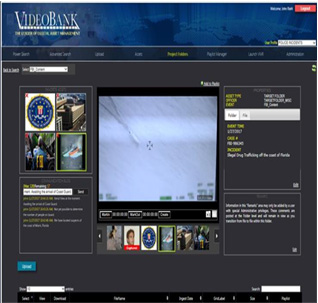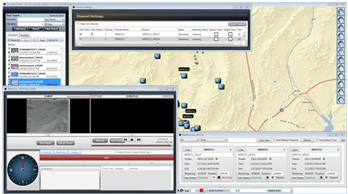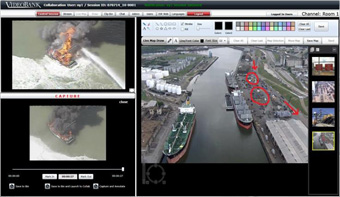Introduces VideoBank's Video Processing, Exploitation and Dissemination Systems
DCM – Digital Content Manager™
VideoBank’s Digital Content Manager™ (DCM) resides at the core of the company’s digital asset management and collaboration product offering. Browser-based, this software application is accessible from any type of computing device (i.e., computers, tablets and smartphones) and is compatible with each of the industry’s most frequently used web browsers – Internet Explorer (IE), Mozilla Firefox, Safari and Chrome.

LMV – Live Map Viewer
The VideoBank Live Map Viewer (LMV) is an advanced video and metadata fusion tool. It incorporates live stream capture, file ingest, advanced search, temporal tagging, video editing, geospatial asset tracking, video content redaction and more — all in one cohesive interface.

The LMV map UI displays geospatial metadata extracted from various sensors. The screen shot shows geospatial reference points extracted from the video stream. Analysts can control playback by using the player’s scrubbing controls or by clicking on the map tic marks. Adjusting the point-in-time video position in one mode synchronizes to the same position in the other mode. For example, scrubbing to a different point in the video player moves the current position tic mark on the map and vice-versa. Other icons on the map below indicate the creation of products and images based on their related geospatial metadata. These capabilities give users unparalleled flexibility in analyzing an area of interest.
VMR – VideoBank’s Virtual Meeting Room
VMR facilitates an advanced sharing and distribution capability which enables users to link content, data, maps, reports, graphics and other sources into a private, collaborative environment.

The VMR facilitates the Processing, Exploitation and Dissemination (PED) of actionable intelligence within a dynamic environment that functions in high or low bandwidth situations. The VMR also incorporates the use of synchronous chat room, messaging, alerting and shared file access technologies. When associated with VideoBank’s data asset management tools, the VMR will
enable local or globally disparate teams to share information and collaborate in ways never before possible—without regard to low bandwidth limitations.
Formats
- VideoBank supports a range of Live and Post capture, import and export formats.
- VideoBank can store and manage any type of media file format in its native essence
- All video formats used for high and low bandwidth applications from uncompressed down to frame-based analysis and distribution
- VideoBank has responded with solutions to formats that are non- standard and unstable video sources
- Video, Images and documents: JPEG, Exif, TIFF, GIF, PNG, SVG, MXF, MXF, MP4, WMV, QuickTime, MPEG2, 4k, 1080, DNxHD, Apple ProRes, H264, Panasonic DVCpro25/50/100, full Microsoft Suite, XLS, DOC, PPT, VSD etc.
- ZIP and compressed formats are supported.
- Capturing and importing legacy system content, utilizing a very mature set of utilities, named ‘VB MAID.’ The automated and semi- automated ingest of content is critical to reducing redundant manpower.
- VB MAID is available as part of VideoBank’s Migration Manager, Hierarchical Storage Manager (HSM) and Folder Manager, and uses a simple, built-in drag and drop functionality, which is spread throughout various modules and at multiple insertion points in any type of video asset management workflow.
- Proprietary non-standard formats are supported. All files with an extension can be managed.
Streams and Control
- Direct RTSP, UDP and SRT Capture
- Direct PTZ Cam control for AXIS, Panasonic and Canon and Pelco,
- OMNIF compatibility
Standards
- MISB and SMPTE compliant- STANAG 4586 and STANAG 4609
- Video and KLV Standards 0104.1 and MISB ST 0601
- Exploitation Support Data (ESD) Close Captioning and Telemetry Support
- VideoBank adheres to MISB standards and can be configured to process nonstandard sources, resulting in the normalization and standardization of files and streams for archive and distribution throughout the enterprise.

